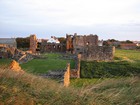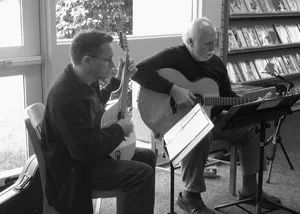

Acoustic duet of guitar and mandolin playing traditional music of American, Irish and Scottish origins.
Bill Wooten and Albert Hollan have played in bands together for years, but only recently began to explore the guitar and mandolin as a duet. Carefully choosing tunes that allow the two instruments to complement each other, they strive to combine the best attributes of the two instruments with a simple style that is both pleasing and yet leaves the listener wanting more. Bill Wooten is a skilled multi-instrumentalist, but the guitar is his first choice because it allows him to create a driving rhythm, play a melody, or gently accompany with melodic fingerpicking. Albert Hollan came to the mandolin more recently and is now exploring the deeper, more resonant sounds of the octave mandolin. Together, the guitar and mandolin make lovely duets that are honest and unadorned by electronic processing. This is the music that you wish you could find more often, but usually will only hear live when two musicians sit down together in a quiet place and begin to speak with their instruments.
Song Info
Track Files
Story behind the song